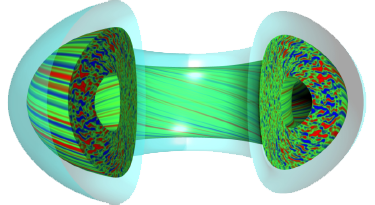Speaker
Description
A real-time disruption predictor based on deep learning method is implemented into the Plasma Control System (PCS) of HL-2A. This upgrade consists of four parts:
1. The Data Acquisition System (DAS) of HL-2A is updated to provide real-time signals to PCS
2. The disruption prediction algorithm proposed in reference 1 is adjusted to reach a higher calculation speed.
3. The PCS, which is developed with C++ language, will call python interpreter and use TFLite framework to execute the disruption prediction algorithm, which is developed with python language and in Tensorflow framework.
The PCS is connected to the Massive Gas Injection (MGI) system to send disruption alarms.
The input signal list of disruption predictor is quite different from the one mentioned in reference 1 because many signals in the original version can’t be obtained in real time. In the real-time disruption predictor, only two kinds of data sources are used. Firstly, raw signals are collected from each diagnostic system by hard connect the PCS acquisition card and the diagnostic systems. Secondly, some feedback control signals and preset signals are provided by PCS.
As for the algorithm, 2 main adjustments are made on top of the version in reference 1. Most convolutional layers are replaced by recurrent layers to avoid redundant calculation. Input signals with high sample rates are down sampled by neural networks. Figure 1 shows the structure of model used in this research. These adjustments can reduce the algorithm’s calculation time from 17ms per slice to 2ms per slice.
Besides, further acceleration can be realized by TFLite framework, which can automatically implement a series of optimizations, such as quantization, to speed up the execution of deep learning models. By utilizing TFLite framework, the calculation time can be reduced from 2ms per slice to 0.3ms per slice.
Using C++ language to call python interpreter is a pretty good way to connect the PCS and disruption predictor. The cross language calling only brings a delay of several microseconds and can minimize the influence on the two connected parts.
Figure 2 gives the flowchart of disruption prediction module in PCS. The input signals are collected by PCS and then fed into the model by cross language calling between C++ and python. The output of algorithm will be sent back to PCS. Finally the PCS will decide whether or not to send a disruption alarm to MGI system. The disruption prediction module is tested in a simulated real-time environment to predict disruptions in Shot Nos. 35000-37000 in HL-2A. The result shows that all the calculation can be finished within 1ms. The accuracy of the algorithm is evaluated by Area Under receiver-operator characteristic Curve (AUC) and the result is 0.925.
Figure 1. Structure of the deep learning model.
Figure 2. Flowchart of disruption prediction module in PCS
Reference
1. Z. Yang, et al, Nucl. Fusion 60 (2020) 016017
| Country or International Organisation | China |
|---|---|
| Affiliation | Southwestern Institute of Physics |

